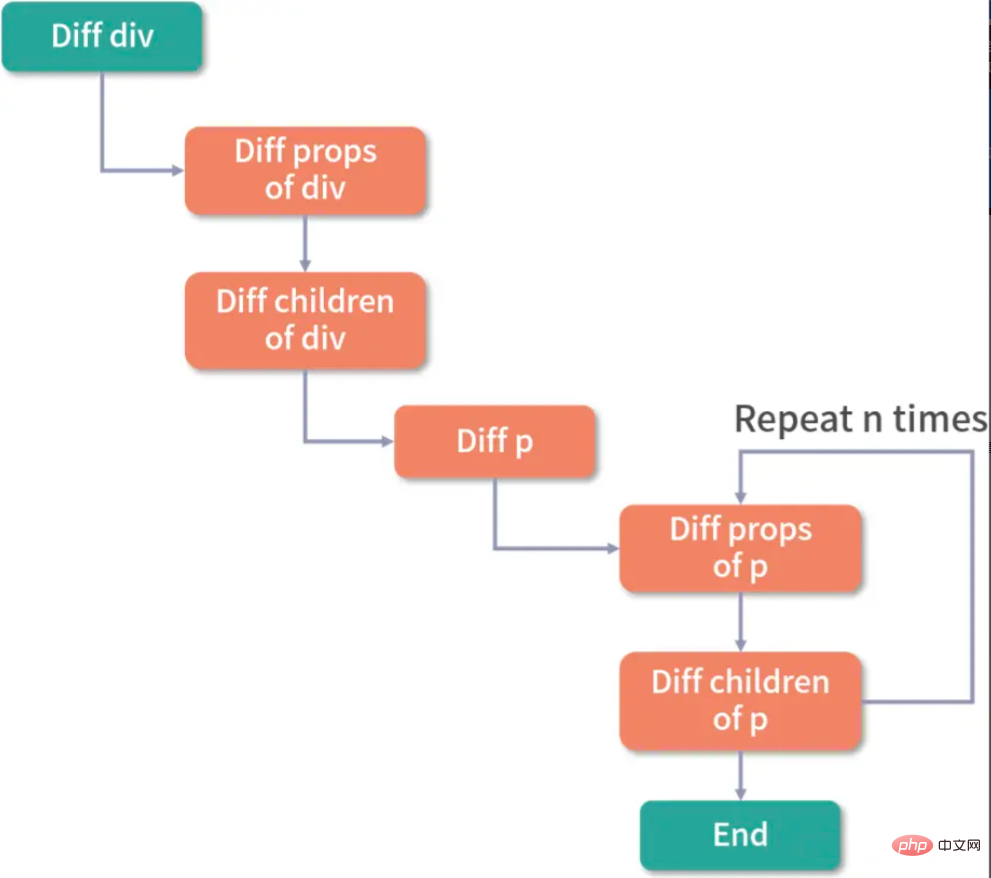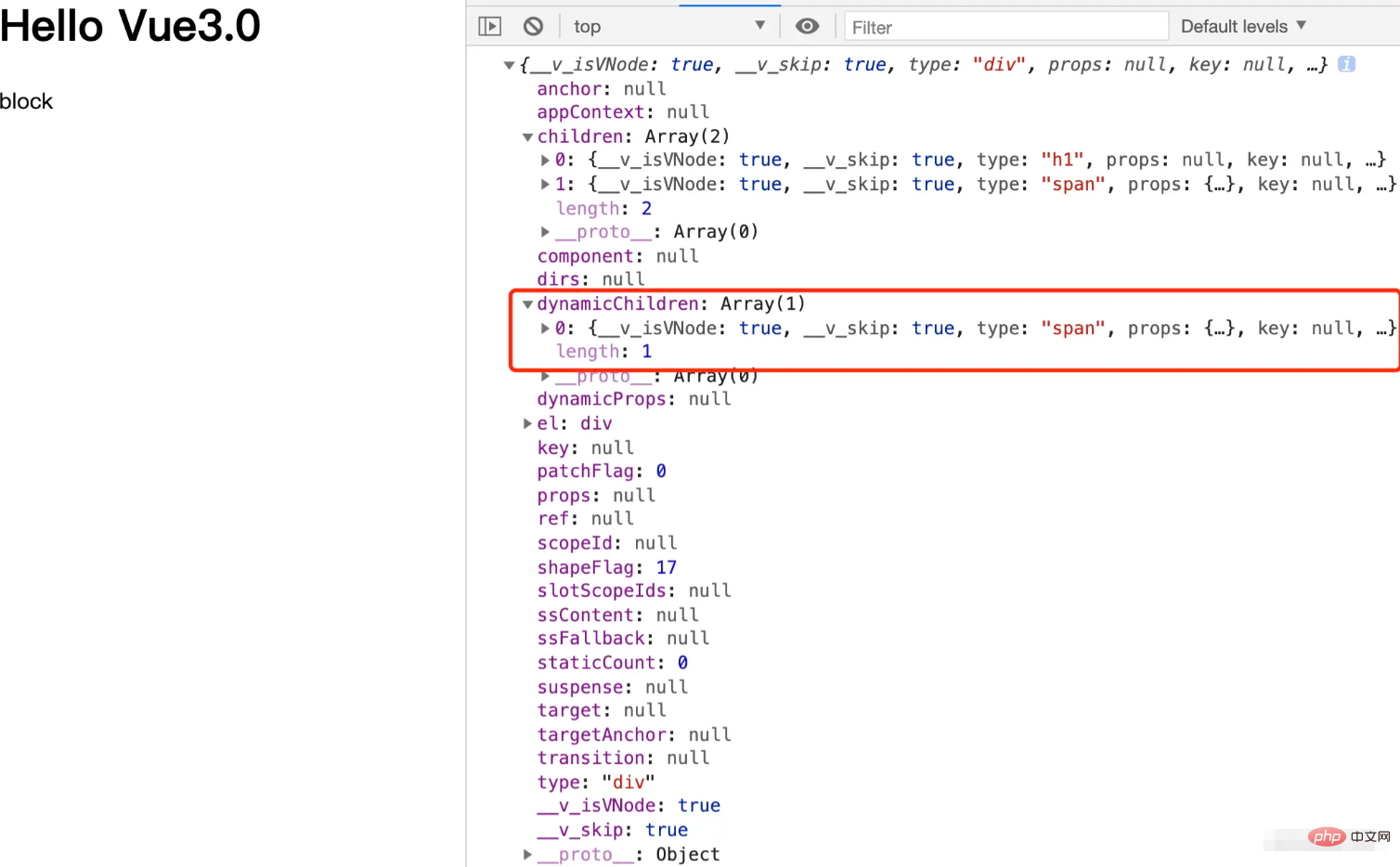 interface Web
interface Web
 Questions et réponses frontales
Questions et réponses frontales
 Quelles optimisations ont été faites dans la compilation vue3 ?
Quelles optimisations ont été faites dans la compilation vue3 ?
Quelles optimisations ont été faites dans la compilation vue3 ?
Les optimisations de compilation de
vue3 incluent : 1. Le patchFlag est introduit pour marquer le contenu dynamique ; pendant le processus de compilation, différentes étiquettes seront marquées en fonction de différents types d'attributs, réalisant ainsi un algorithme de comparaison rapide. 2. Arbre de blocs. 3. La promotion statique consiste à promouvoir des nœuds ou des attributs statiques. 4. Pré-analyse de la stringification, lorsqu'il y a plus de 10 nœuds statiques consécutifs, les nœuds statiques seront sérialisés en chaînes. 5. Mise en cache des fonctions ; après avoir activé l’option cacheHandlers, la fonction sera mise en cache et pourra être utilisée directement plus tard.

L'environnement d'exploitation de ce tutoriel : système windows7, version vue3, ordinateur DELL G3.
Cet article analyse principalement l'optimisation effectuée dans la phase de compilation Vue3.0, et comment utiliser ces stratégies d'optimisation pour réduire le nombre de comparaisons dans la phase patch.
Étant donné que l'intégralité de l'arborescence vnode du composant doit encore être parcourue lorsque le composant est mis à jour, comme le modèle suivant : Vue3.0 编译阶段做的优化,在 patch 阶段是如何利用这些优化策略来减少比对次数。
由于组件更新时依然需要遍历该组件的整个 vnode 树,比如下面这个模板:
<template>
<div id="container">
<p class="text">static text</p>
<p class="text">static text</p>
<p class="text">{{ message }}</p>
<p class="text">static text</p>
<p class="text">static text</p>
</div>
</template>整个 diff 过程如图所示:

可以看到,因为这段代码中只有一个动态节点,所以这里有很多 diff 和遍历其实都是不需要的,这就会导致 vnode 的性能跟模版大小正相关,跟动态节点的数量无关,当一些组件的整个模版内只有少量动态节点时,这些遍历都是性能的浪费。对于上述例子,理想状态只需要 diff 这个绑定 message 动态节点的 p 标签即可。
Vue.js 3.0 通过编译阶段对静态模板的分析,编译生成了 Block tree。
Block tree 是一个将模板基于动态节点指令切割的嵌套区块,每个区块内部的节点结构是固定的,而且每个区块只需要以一个 Array 来追踪自身包含的动态节点。借助 Block tree,Vue.js 将 vnode 更新性能由与模版整体大小相关提升为与动态内容的数量相关,这是一个非常大的性能突破。
PatchFlag
由于 diff 算法无法避免新旧虚拟 DOM 中无用的比较操作,Vue.js 3.0 引入了 patchFlag,用来标记动态内容。在编译过程中会根据不同的属性类型打上不同的标识,从而实现了快速 diff 算法。PatchFlags 的所有枚举类型如下所示:
export const enum PatchFlags {
TEXT = 1, // 动态文本节点
CLASS = 1 << 1, // 动态class
STYLE = 1 << 2, // 动态style
PROPS = 1 << 3, // 除了class、style动态属性
FULL_PROPS = 1 << 4, // 有key,需要完整diff
HYDRATE_EVENTS = 1 << 5, // 挂载过事件的
STABLE_FRAGMENT = 1 << 6, // 稳定序列,子节点顺序不会发生变化
KEYED_FRAGMENT = 1 << 7, // 子节点有key的fragment
UNKEYED_FRAGMENT = 1 << 8, // 子节点没有key的fragment
NEED_PATCH = 1 << 9, // 进行非props比较, ref比较
DYNAMIC_SLOTS = 1 << 10, // 动态插槽
DEV_ROOT_FRAGMENT = 1 << 11,
HOISTED = -1, // 表示静态节点,内容变化,不比较儿子
BAIL = -2 // 表示diff算法应该结束
}Block Tree

左侧的 template 经过编译后会生成右侧的 render 函数,里面有 _openBlock、_createElementBlock、_toDisplayString、_createElementVNode(createVnode) 等辅助函数。
let currentBlock = null
function _openBlock() {
currentBlock = [] // 用一个数组来收集多个动态节点
}
function _createElementBlock(type, props, children, patchFlag) {
return setupBlock(createVnode(type, props, children, patchFlag));
}
export function createVnode(type, props, children = null, patchFlag = 0) {
const vnode = {
type,
props,
children,
el: null, // 虚拟节点上对应的真实节点,后续diff算法
key: props?.["key"],
__v_isVnode: true,
shapeFlag,
patchFlag
};
...
if (currentBlock && vnode.patchFlag > 0) {
currentBlock.push(vnode);
}
return vnode;
}
function setupBlock(vnode) {
vnode.dynamicChildren = currentBlock;
currentBlock = null;
return vnode;
}
function _toDisplayString(val) {
return isString(val)
? val
: val == null
? ""
: isObject(val)
? JSON.stringify(val)
: String(val);
}此时生成的 vnode 如下:

此时生成的虚拟节点多出一个 dynamicChildren 属性,里面收集了动态节点 span。
节点 diff 优化策略:
我们之前分析过,在 patch 阶段更新节点元素的时候,会执行 patchElement 函数,我们再来回顾一下它的实现:
const patchElement = (n1, n2) => { // 先复用节点、在比较属性、在比较儿子
let el = n2.el = n1.el;
let oldProps = n1.props || {}; // 对象
let newProps = n2.props || {}; // 对象
patchProps(oldProps, newProps, el);
if (n2.dynamicChildren) { // 只比较动态元素
patchBlockChildren(n1, n2);
} else {
patchChildren(n1, n2, el); // 全量 diff
}
}我们在前面组件更新的章节分析过这个流程,在分析子节点更新的部分,当时并没有考虑到优化的场景,所以只分析了全量比对更新的场景。
而实际上,如果这个 vnode 是一个 Block vnode,那么我们不用去通过 patchChildren 全量比对,只需要通过 patchBlockChildren 去比对并更新 Block 中的动态子节点即可。
由此可以看出性能被大幅度提升,从 tree 级别的比对,变成了线性结构比对。
我们来看一下它的实现:
const patchBlockChildren = (n1, n2) => {
for (let i = 0; i < n2.dynamicChildren.length; i++) {
patchElement(n1.dynamicChildren[i], n2.dynamicChildren[i])
}
}属性 diff 优化策略:
接下来我们看一下属性比对的优化策略:
const patchElement = (n1, n2) => { // 先复用节点、在比较属性、在比较儿子
let el = n2.el = n1.el;
let oldProps = n1.props || {}; // 对象
let newProps = n2.props || {}; // 对象
let { patchFlag, dynamicChildren } = n2
if (patchFlag > 0) {
if (patchFlag & PatchFlags.FULL_PROPS) { // 对所 props 都进行比较更新
patchProps(el, n2, oldProps, newProps, ...)
} else {
// 存在动态 class 属性时
if (patchFlag & PatchFlags.CLASS) {
if (oldProps.class !== newProps.class) {
hostPatchProp(el, 'class', null, newProps.class, ...)
}
}
// 存在动态 style 属性时
if (patchFlag & PatchFlags.STYLE) {
hostPatchProp(el, 'style', oldProps.style, newProps.style, ...)
}
// 针对除了 style、class 的 props
if (patchFlag & PatchFlags.PROPS) {
const propsToUpdate = n2.dynamicProps!
for (let i = 0; i < propsToUpdate.length; i++) {
const key = propsToUpdate[i]
const prev = oldProps[key]
const next = newProps[key]
if (next !== prev) {
hostPatchProp(el, key, prev, next, ...)
}
}
}
if (patchFlag & PatchFlags.TEXT) { // 存在动态文本
if (n1.children !== n2.children) {
hostSetElementText(el, n2.children as string)
}
}
} else if (dynamicChildren == null) {
patchProps(el, n2, oldProps, newProps, ...)
}
}
}
function hostPatchProp(el, key, prevValue, nextValue) {
if (key === 'class') { // 更新 class
patchClass(el, nextValue)
} else if (key === 'style') { // 更新 style
patchStyle(el, prevValue, nextValue)
} else if (/^on[^a-z]/.test(key)) { // events addEventListener
patchEvent(el, key, nextValue);
} else { // 普通属性 el.setAttribute
patchAttr(el, key, nextValue);
}
}
function patchClass(el, nextValue) {
if (nextValue == null) {
el.removeAttribute('class'); // 如果不需要class直接移除
} else {
el.className = nextValue
}
}
function patchStyle(el, prevValue, nextValue = {}){
...
}
function patchAttr(el, key, nextValue){
...
}总结: vue3 会充分利用 patchFlag 和 dynamicChildren 做优化。如果确定只是某个局部的变动,比如 style 改变,那么只会调用 hostPatchProp 并传入对应的参数 style 做特定的更新(靶向更新);如果有 dynamicChildren,会执行 patchBlockChildren
<div>
<span>hello</span>
<span a=1 b=2>{{name}}</span>
<a><span>{{age}}</span></a>
</div>
 Vous pouvez le voir parce que il n'y a qu'un seul nœud dynamique dans ce code, il y a donc ici beaucoup de différences et de traversées qui sont en fait inutiles. Cela entraînera que les performances de vnode soient directement liées à la taille du modèle et n'ont rien à voir avec le nombre de dynamiques. Lorsque certains composants n'ont qu'un petit nombre de nœuds dynamiques dans l'ensemble du modèle, ces traversées constituent un gaspillage de performances. Pour l'exemple ci-dessus, idéalement, il vous suffit de comparer la balise p du nœud dynamique du message lié.
Vous pouvez le voir parce que il n'y a qu'un seul nœud dynamique dans ce code, il y a donc ici beaucoup de différences et de traversées qui sont en fait inutiles. Cela entraînera que les performances de vnode soient directement liées à la taille du modèle et n'ont rien à voir avec le nombre de dynamiques. Lorsque certains composants n'ont qu'un petit nombre de nœuds dynamiques dans l'ensemble du modèle, ces traversées constituent un gaspillage de performances. Pour l'exemple ci-dessus, idéalement, il vous suffit de comparer la balise p du nœud dynamique du message lié.
Vue.js 3.0 Grâce à l'analyse des modèles statiques lors de la phase de compilation, l'Arbre de blocs est compilé et généré. 🎜🎜Block tree est un bloc imbriqué qui coupe le modèle en fonction des instructions de nœud dynamiques. La structure des nœuds à l'intérieur de chaque bloc est fixe et chaque bloc n'a besoin que d'un seul Tableau pour être suivi. les nœuds dynamiques qu'il contient. Avec l'aide de l'Block tree, 🎜Vue.js améliore les performances de mise à jour du vnode, non plus liées à la taille globale du modèle, mais liées à la quantité de contenu dynamique. Il s'agit d'une très grande avancée en termes de performances. . 🎜🎜PatchFlag🎜
🎜Puisque l'algorithmediff ne peut pas éviter les opérations de comparaison inutiles dans l'ancien et le nouveau DOM</code virtuel >, < code>Vue.js 3.0 introduit patchFlag pour marquer le contenu dynamique. Pendant le processus de compilation, différents identifiants seront marqués en fonction de différents types d'attributs, réalisant ainsi un algorithme diff rapide. Tous les types d'énumérations pour PatchFlags sont les suivants : 🎜export function render(_ctx, _cache, $props, $setup, $data, $options) {
return (_openBlock(), _createElementBlock("div", null, [
_createElementVNode("span", null, "hello"),
_createElementVNode("span", {
a: "1",
b: "2"
}, _toDisplayString(_ctx.name), 1 /* TEXT */),
_createElementVNode("a", null, [
_createElementVNode("span", null, _toDisplayString(_ctx.age), 1 /* TEXT */)
])
]))
}🎜Block Tree🎜
🎜 🎜🎜Le
🎜🎜Le modèle à gauche est compilé Ensuite, la fonction render sur le côté droit sera générée, qui contient _openBlock, _createElementBlock, _toDisplayString, _createElementVNode< /code>(<code>createVnode) et d'autres fonctions auxiliaires. 🎜const _hoisted_1 = /*#__PURE__*/_createElementVNode("span", null, "hello", -1 /* HOISTED */)
const _hoisted_2 = {
a: "1",
b: "2"
}
export function render(_ctx, _cache, $props, $setup, $data, $options) {
return (_openBlock(), _createElementBlock("div", null, [
_hoisted_1,
_createElementVNode("span", _hoisted_2, _toDisplayString(_ctx.name), 1 /* TEXT */),
_createElementVNode("a", null, [
_createElementVNode("span", null, _toDisplayString(_ctx.age), 1 /* TEXT */)
])
]))
} 🎜🎜Le nœud virtuel généré à ce moment a un attribut
🎜🎜Le nœud virtuel généré à ce moment a un attribut dynamicChildren supplémentaire, qui collecte les nœuds dynamiques span. 🎜🎜Stratégie d'optimisation des différences de nœud :🎜
🎜Nous avons analysé auparavant lors de la mise à jour des éléments de nœud dans l'étapepatch, patchElement, passons en revue son implémentation : 🎜<div> <span>static</span> <span>static</span> <span>static</span> <span>static</span> <span>static</span> <span>static</span> <span>static</span> <span>static</span> <span>static</span> <span>static</span> </div>
vnode est un Block vnode, alors nous n'avons pas besoin de passer par patchChildren pour une comparaison complète, nous seulement il faut passer par patchBlockChildren pour comparer et mettre à jour les nœuds enfants dynamiques dans Block.
On peut voir que les performances ont été grandement améliorées, de la comparaison au niveau de l'arbre à la comparaison de la structure linéaire. 🎜🎜Jetons un coup d'œil à sa mise en œuvre :🎜const _hoisted_1 = /*#__PURE__*/_createStaticVNode("<span>static</span><span>static</span><span>static</span><span>static</span><span>static</span><span>static</span><span>static</span><span>static</span><span>static</span><span>static</span>", 10)
const _hoisted_11 = [ _hoisted_1]
export function render(_ctx, _cache, $props, $setup, $data, $options) {
return (_openBlock(), _createElementBlock("div", null, _hoisted_11))
}🎜Stratégie d'optimisation des différences d'attributs :🎜
🎜Jetons ensuite un coup d'œil à la stratégie d'optimisation pour la comparaison d'attributs :🎜<div @click="event => v = event.target.value"></div>
vue3 utilisera pleinement patchFlag et dynamicChildren pour l'optimisation. S'il est déterminé qu'il n'y a qu'un changement local, tel qu'un changement de style, alors seul hostPatchProp sera appelé et le paramètre correspondant style sera être transmis pour effectuer une mise à jour spécifique. (🎜Mise à jour ciblée🎜) ; S'il y a dynamicChildren, patchBlockChildren sera exécuté pour comparaison et mise à jour. ne pas être entièrement comparé et mis à jour à chaque fois🎜. Le schéma est le suivant : 🎜🎜🎜🎜静态提升
静态提升是将静态的节点或者属性提升出去,假设有以下模板:
<div>
<span>hello</span>
<span a=1 b=2>{{name}}</span>
<a><span>{{age}}</span></a>
</div>编译生成的 render 函数如下:
export function render(_ctx, _cache, $props, $setup, $data, $options) {
return (_openBlock(), _createElementBlock("div", null, [
_createElementVNode("span", null, "hello"),
_createElementVNode("span", {
a: "1",
b: "2"
}, _toDisplayString(_ctx.name), 1 /* TEXT */),
_createElementVNode("a", null, [
_createElementVNode("span", null, _toDisplayString(_ctx.age), 1 /* TEXT */)
])
]))
}我们把模板编译成 render 函数是这个酱紫的,那么问题就是每次调用 render 函数都要重新创建虚拟节点。
开启静态提升 hoistStatic 选项后
const _hoisted_1 = /*#__PURE__*/_createElementVNode("span", null, "hello", -1 /* HOISTED */)
const _hoisted_2 = {
a: "1",
b: "2"
}
export function render(_ctx, _cache, $props, $setup, $data, $options) {
return (_openBlock(), _createElementBlock("div", null, [
_hoisted_1,
_createElementVNode("span", _hoisted_2, _toDisplayString(_ctx.name), 1 /* TEXT */),
_createElementVNode("a", null, [
_createElementVNode("span", null, _toDisplayString(_ctx.age), 1 /* TEXT */)
])
]))
}预解析字符串化
静态提升的节点都是静态的,我们可以将提升出来的节点字符串化。 当连续静态节点超过 10 个时,会将静态节点序列化为字符串。
假如有如下模板:
<div> <span>static</span> <span>static</span> <span>static</span> <span>static</span> <span>static</span> <span>static</span> <span>static</span> <span>static</span> <span>static</span> <span>static</span> </div>
开启静态提升 hoistStatic 选项后
const _hoisted_1 = /*#__PURE__*/_createStaticVNode("<span>static</span><span>static</span><span>static</span><span>static</span><span>static</span><span>static</span><span>static</span><span>static</span><span>static</span><span>static</span>", 10)
const _hoisted_11 = [ _hoisted_1]
export function render(_ctx, _cache, $props, $setup, $data, $options) {
return (_openBlock(), _createElementBlock("div", null, _hoisted_11))
}函数缓存
假如有如下模板:
<div @click="event => v = event.target.value"></div>
编译后:
const _hoisted_1 = ["onClick"]
export function render(_ctx, _cache, $props, $setup, $data, $options) {
return (_openBlock(), _createElementBlock("div", {
onClick: event => _ctx.v = event.target.value
}, null, 8 /* PROPS */, _hoisted_1))
}每次调用 render 的时候要创建新函数,开启函数缓存 cacheHandlers 选项后,函数会被缓存起来,后续可以直接使用
export function render(_ctx, _cache, $props, $setup, $data, $options) {
return (_openBlock(), _createElementBlock("div", {
onClick: _cache[0] || (_cache[0] = event => _ctx.v = event.target.value)
}))
}总结
以上几点即为 Vuejs 在编译阶段做的优化,基于上面几点,Vuejs 在 patch 过程中极大地提高了性能。
Ce qui précède est le contenu détaillé de. pour plus d'informations, suivez d'autres articles connexes sur le site Web de PHP en chinois!

Outils d'IA chauds

Undresser.AI Undress
Application basée sur l'IA pour créer des photos de nu réalistes

AI Clothes Remover
Outil d'IA en ligne pour supprimer les vêtements des photos.

Undress AI Tool
Images de déshabillage gratuites

Clothoff.io
Dissolvant de vêtements AI

AI Hentai Generator
Générez AI Hentai gratuitement.

Article chaud

Outils chauds

Bloc-notes++7.3.1
Éditeur de code facile à utiliser et gratuit

SublimeText3 version chinoise
Version chinoise, très simple à utiliser

Envoyer Studio 13.0.1
Puissant environnement de développement intégré PHP

Dreamweaver CS6
Outils de développement Web visuel

SublimeText3 version Mac
Logiciel d'édition de code au niveau de Dieu (SublimeText3)
 Un article pour parler du contrôle de la mémoire dans Node
Apr 26, 2023 pm 05:37 PM
Un article pour parler du contrôle de la mémoire dans Node
Apr 26, 2023 pm 05:37 PM
Le service Node construit sur une base non bloquante et piloté par les événements présente l'avantage d'une faible consommation de mémoire et est très adapté à la gestion de requêtes réseau massives. Dans le contexte de demandes massives, les questions liées au « contrôle de la mémoire » doivent être prises en compte. 1. Le mécanisme de récupération de place du V8 et les limitations de mémoire Js sont contrôlés par la machine de récupération de place
 PHP et Vue : une combinaison parfaite d'outils de développement front-end
Mar 16, 2024 pm 12:09 PM
PHP et Vue : une combinaison parfaite d'outils de développement front-end
Mar 16, 2024 pm 12:09 PM
PHP et Vue : une combinaison parfaite d'outils de développement front-end À l'ère actuelle de développement rapide d'Internet, le développement front-end est devenu de plus en plus important. Alors que les utilisateurs ont des exigences de plus en plus élevées en matière d’expérience des sites Web et des applications, les développeurs front-end doivent utiliser des outils plus efficaces et plus flexibles pour créer des interfaces réactives et interactives. En tant que deux technologies importantes dans le domaine du développement front-end, PHP et Vue.js peuvent être considérés comme une arme parfaite lorsqu'ils sont associés. Cet article explorera la combinaison de PHP et Vue, ainsi que des exemples de code détaillés pour aider les lecteurs à mieux comprendre et appliquer ces deux éléments.
 Comment résoudre les problèmes cross-domaines ? Une brève analyse des solutions courantes
Apr 25, 2023 pm 07:57 PM
Comment résoudre les problèmes cross-domaines ? Une brève analyse des solutions courantes
Apr 25, 2023 pm 07:57 PM
Le cross-domaine est un scénario souvent rencontré en développement, et c'est également une question souvent abordée lors des entretiens. La maîtrise des solutions interdomaines communes et des principes qui les sous-tendent peut non seulement améliorer notre efficacité de développement, mais également mieux performer lors des entretiens.
 Comment utiliser le langage Go pour le développement front-end ?
Jun 10, 2023 pm 05:00 PM
Comment utiliser le langage Go pour le développement front-end ?
Jun 10, 2023 pm 05:00 PM
Avec le développement de la technologie Internet, le développement front-end est devenu de plus en plus important. La popularité des appareils mobiles, en particulier, nécessite une technologie de développement frontal efficace, stable, sûre et facile à entretenir. En tant que langage de programmation en développement rapide, le langage Go est utilisé par de plus en plus de développeurs. Alors, est-il possible d’utiliser le langage Go pour le développement front-end ? Ensuite, cet article expliquera en détail comment utiliser le langage Go pour le développement front-end. Voyons d’abord pourquoi le langage Go est utilisé pour le développement front-end. Beaucoup de gens pensent que le langage Go est un
 Questions fréquemment posées par les enquêteurs front-end
Mar 19, 2024 pm 02:24 PM
Questions fréquemment posées par les enquêteurs front-end
Mar 19, 2024 pm 02:24 PM
Lors des entretiens de développement front-end, les questions courantes couvrent un large éventail de sujets, notamment les bases HTML/CSS, les bases JavaScript, les frameworks et les bibliothèques, l'expérience du projet, les algorithmes et les structures de données, l'optimisation des performances, les requêtes inter-domaines, l'ingénierie front-end, les modèles de conception et les nouvelles technologies et tendances. Les questions de l'intervieweur sont conçues pour évaluer les compétences techniques du candidat, son expérience en matière de projet et sa compréhension des tendances du secteur. Par conséquent, les candidats doivent être parfaitement préparés dans ces domaines pour démontrer leurs capacités et leur expertise.
 En savoir plus sur les tampons dans Node
Apr 25, 2023 pm 07:49 PM
En savoir plus sur les tampons dans Node
Apr 25, 2023 pm 07:49 PM
Au début, JS ne fonctionnait que du côté du navigateur. Il était facile de traiter les chaînes codées en Unicode, mais il était difficile de traiter les chaînes binaires et non codées en Unicode. Et le binaire est le format de données le plus bas du package ordinateur, vidéo/audio/programme/réseau.
 Django est-il front-end ou back-end ? Vérifiez-le!
Jan 19, 2024 am 08:37 AM
Django est-il front-end ou back-end ? Vérifiez-le!
Jan 19, 2024 am 08:37 AM
Django est un framework d'application Web écrit en Python qui met l'accent sur un développement rapide et des méthodes propres. Bien que Django soit un framework Web, pour répondre à la question de savoir si Django est un front-end ou un back-end, vous devez avoir une compréhension approfondie des concepts de front-end et de back-end. Le front-end fait référence à l'interface avec laquelle les utilisateurs interagissent directement, et le back-end fait référence aux programmes côté serveur. Ils interagissent avec les données via le protocole HTTP. Lorsque le front-end et le back-end sont séparés, les programmes front-end et back-end peuvent être développés indépendamment pour mettre en œuvre respectivement la logique métier et les effets interactifs, ainsi que l'échange de données.
 Golang peut-il être utilisé comme frontal ?
Jun 06, 2023 am 09:19 AM
Golang peut-il être utilisé comme frontal ?
Jun 06, 2023 am 09:19 AM
Golang peut être utilisé comme frontal. Golang est un langage de programmation très polyvalent qui peut être utilisé pour développer différents types d'applications, y compris des applications frontales. En utilisant Golang pour écrire le front-end, vous pouvez vous débarrasser d'un front-end. série de problèmes causés par des langages tels que JavaScript. Par exemple, des problèmes tels qu'une mauvaise sécurité des types, de faibles performances et un code difficile à maintenir.





